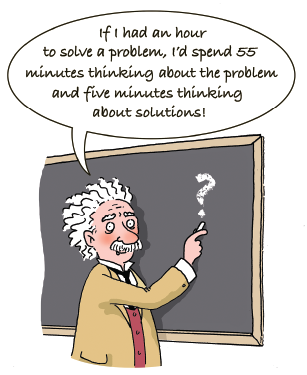|
Getting your Trinity Audio player ready...
|
If one had to list the top skills needed for a product manager, something that will be high up on that list is “Problem-Solving”. In order to effectively solve a problem, you need to understand the problem really well. When you do, you will be able to define your problem statement.
“People Don’t Want Quarter Inch Drills. They Want Quarter Inch Holes” – Theodore Levitt
In problem solving the first step is clearly identifying the right problem to solve. Let us jump into a little more detail on this simple yet critical subject-problem statement.
What is a Problem Statement?
- A problem statement is a brief and focused statement describing a specific problem the product aims to solve.
- It provides a clear and concise description of the problem, the target market, and the desired outcome.
- Problem statements differ from goals or objectives, which are broader and more general in scope.

Need more reasons to believe why problem statements are super important? Here you go.
Importance of Defining A Problem Statement
- First of all, they help to clarify the scope of the project. They make sure that everyone involved knows exactly what problem the product is trying to solve. This is super important for making sure that everyone is on the same page and working towards the same goal.
- Another awesome thing about problem statements is that they help to align all the stakeholders around a common goal. When everyone is working together towards the same objective, amazing things can happen!
- Problem statements also guide decision-making throughout the product development lifecycle, ensuring that all decisions are in line with the problem the product is trying to solve. This helps to keep everything on track and moving in the right direction.
- Finally, problem statements help in prioritizing features based on their ability to solve the problem and deliver value to customers. This is key for making sure that the product is delivering real value to its users.
So there you have it – problem statements are pretty important!
When something important goes wrong, a lot of other things can go wrong with it. So, here are some tips to avoid common mistakes when defining problem statements:
Common Pitfalls to Avoid while Defining A Problem Statement
- Narrow focus: It’s important to avoid narrowly defining the problem statement. This is because a product developed in such a way may not address broader market needs or opportunities. It could also limit the product’s impact on different customer groups. Therefore, keeping an open mind and considering a wide range of perspectives is crucial to building a successful product.
- Biased view: Creating problem statements with a broad and unbiased view of the market/business is essential. This helps avoid a situation where problem statements only support existing assumptions and limit innovation. Therefore, it’s crucial to approach problem statements with an open mind and a willingness to explore new ideas. This can lead to more innovative and successful products. Keep an open mind and think outside the box!
- False/Wrong assumptions: It is crucial to base problem statements on accurate and complete information. This is because developing a product that doesn’t solve the real problem or meet the needs of the targeted user groups is a risk. Therefore, ensuring accuracy and completeness is vital to building a successful product. Fact-checking is always a good idea!
- Relying too much on data: Data can help create problem statements. However, relying solely on data may restrict creativity and innovation. This may lead to incremental improvements rather than transformative products. Don’t be afraid to trust your instincts and think outside the box!
Bottom Line
Mastering the art of creating effective problem statements is a critical skill for any product manager. By following the tips and techniques outlined in this article, you can avoid common pitfalls and ensure that your team is aligned around a clear and actionable problem statement.
Remember, a well-crafted problem statement can help you define the scope of your project, align stakeholders, guide decision-making, and prioritize features to deliver value to your customers. So take the time to hone your problem statement skills and watch as your products become more innovative, customer-focused, and successful.
Good luck! Let us know your thoughts!
Watch this space for more product management related articles – engineering.rently.com
Product Owner

